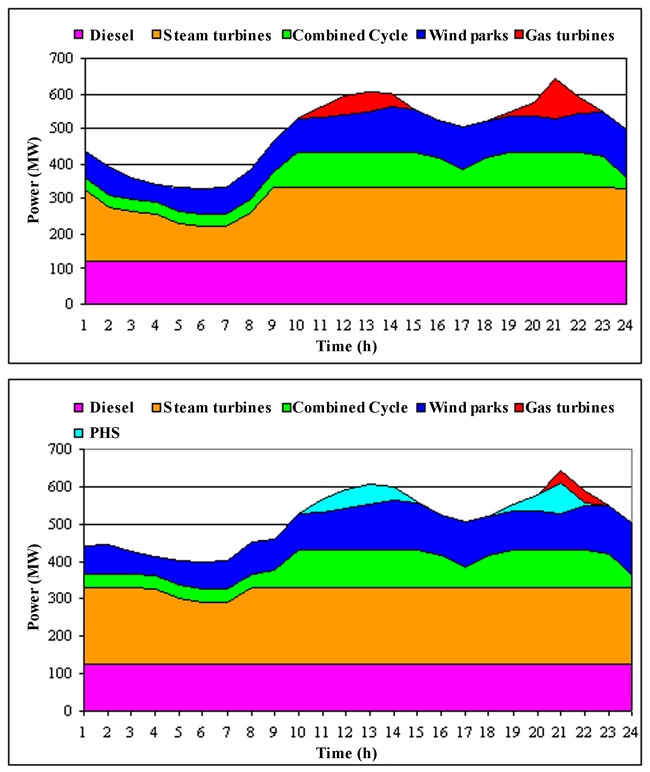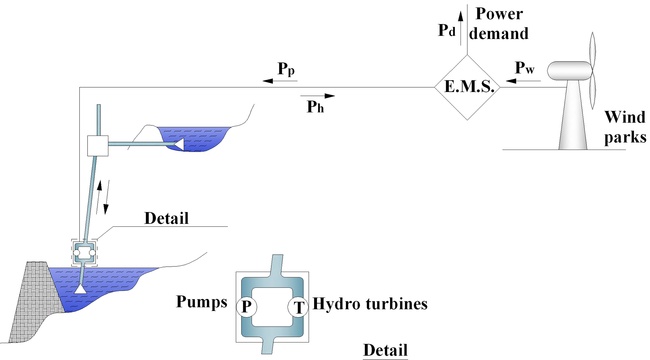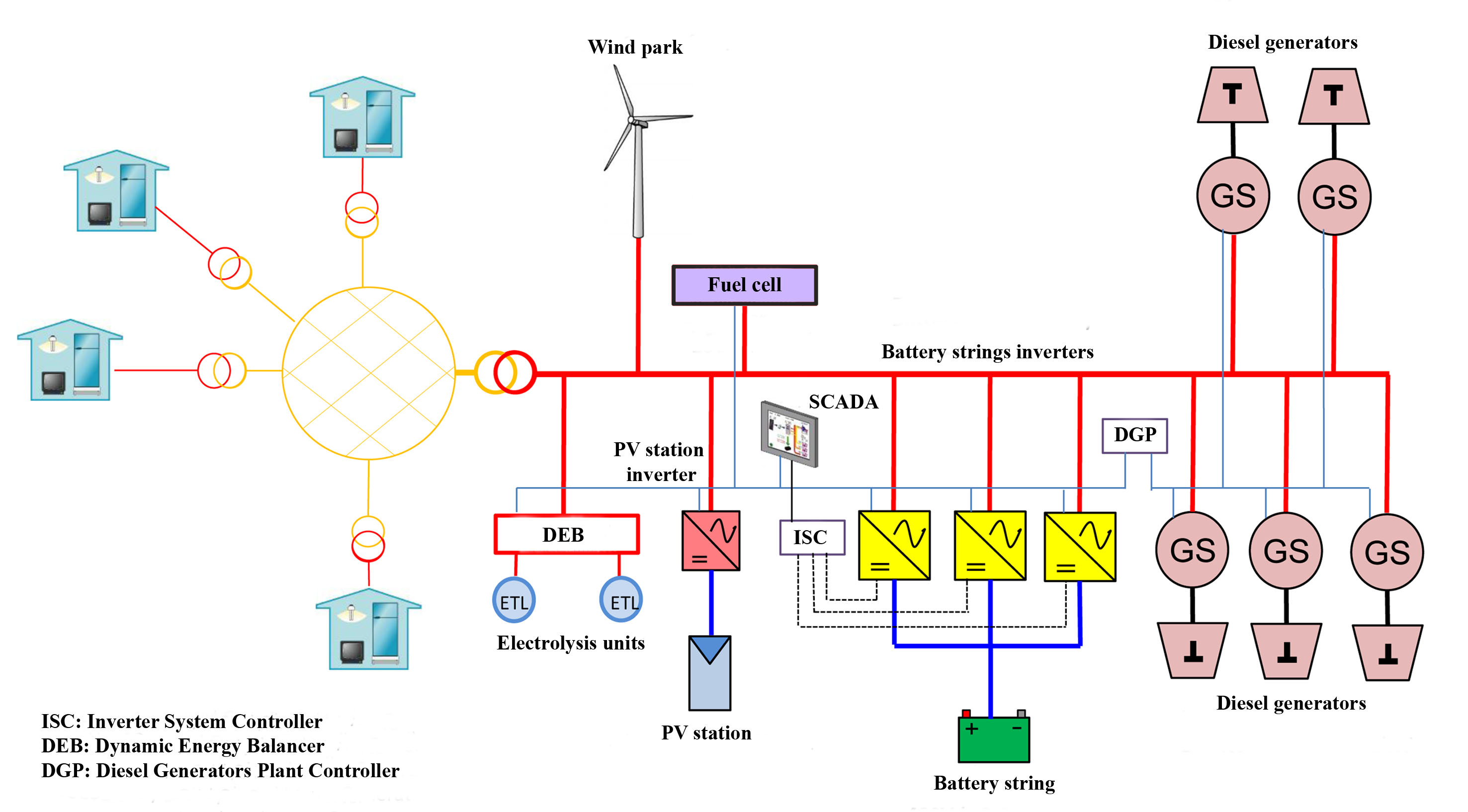Selection criteria for the R.E.S. units
It is obvious that the first parameter that is taken into account for the selection of the optimum Renewable Energy Sources (R.E.S.) technologies for the synthesis of a hybrid power plant is the availability of R.E.S. potential.
In cases that abundant R.E.S. potential is available for more than one R.E.S., the following selection parameters are evaluated:
- the efficiency of the alternative R.E.S. technologies, expressed ultimately with the annual final capacity factor of each candidate R.E.S. power plant
- the set-up cost of each alternative R.E.S. power plant
- other special technical issues, such as the transportation and installation possibilities of the requirement equipment, the seasonal operation of the plant, environmental constraints etc.
Following the abovementioned, the most technically mature and economically competitive technologies for the hybrid power plant base units are:
- wind parks, for hybrid power plants of large and small size
- wind turbines and photovoltaic stations for hybrid power plants of small size.
Selection criteria for the storage units
The storage unit of a hybrid power plant is the plant’s most characteristic component, namely the one that will determine the type and the operating algorithm of the hybrid power plant.
The type of the storage unit is mainly determined by the size of the hybrid power plant, which implies the plant’s storage requirements, regarding both the storage and the charging / discharging capacity.
In hybrid power plants of small size (guaranteed power production up to 1MW), the following alternative storage technologies can be introduced:
- electrochemical batteries of several types (lead acid, redox flow batteries etc)
- fuel cells co-operating with electrolysis units for hydrogen production
- compressed air energy storage systems (CAES).
The above technologies can be also introduced for larger hybrid power plant (up to 5MW), with significant increased set-up and operating specific cost, per unit of stored energy.
In hybrid power plants of large size (guaranteed power production higher than 5MW), the following storage technologies can be employed:
- pumped hydro storage systems (PHS)
- compressed air energy storage systems (CAES).
PHS can be also introduced in hybrid power plants of smaller size (2 – 5MW) and exhibit, under specific conditions (appropriate land morphology, power demand size and annual variation), acceptable economic indices.
Applications of hybrid power plants for electricity production
A hybrid power plant of large size is introduced in an electrical system with the following operating algorithms:
- The continuous cover of the power demand, 24 hours a day, aiming at the 100% annual R.E.S. penetration to the electricity consumption. In this case, very roughly, the hybrid power plant stores energy whenever the available power from the R.E.S. units exceeds the power demand and provides energy for consumption when the reverse situation occurs. A detailed operating algorithm of a wind powered PHS hybrid power plant is available in the following pdf file (774kB).
- The production of guaranteed power during the power demand peak periods. In this case, the hybrid power plant stores energy during night or for 24 hours a day from the R.E.S. units, in order to provide a pre-defined guaranteed power production during the power demand peak daily periods. This procedure is known as “power demand peak shaving”. A detailed operating algorithm of a wind powered PHS / CAES hybrid power plant is available in the following pdf file (82kB).
In the following figure the power production synthesis is presented for a typical 24 hour period during summer, for the autonomous system of Crete, Greece, with and without the presence of a hybrid power plant for power peak shaving. In the upper half of the figure, which refers to the existing synthesis of the thermal power plants in Crete, power during the peak periods is provided by the gas turbines. In the lower half of the figure, it is assumed that a hybrid power plant has been introduced in the electrical grid. In this case, energy is stored in the hybrid power plant during the early morning hours by increasing the power production from the steam turbines, enabling the guaranteed power production from the hybrid power plant during the power demand peak periods, instead of the initially employed gas turbines.

The effect of a hybrid power plant introduced for power peak shaving in a daily power production synthesis of the autonomous electrical system of Crete, Greece.
The operating philosophy of a hybrid power plant consisting of a wind park and a PHS is presented.

Operating philosophy of a hybrid power plant consisting of a wind park and a PHS.
In the next figure a hybrid power plant of small size is presented. It consists of a small wind park (e.g. one or two wind turbines with total power lower than 1MW), a photovoltaic station and electrochemical batteries. This type of hybrid power plants are most commonly introduced to approach the 100% annual cover of the electricity consumption. The analytical operating algorithm for such an operation philosophy is provided in the following pdf file (626kΒ).

Hybrid power plant for electricity production of small size.